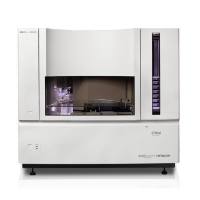sanger和他的DNA测序方法
互联网
相关专题
Sanger酶学法
sanger是英国生物化学家,1918年8月13日生于英格兰格洛斯特夏郡,在剑桥大学圣· 约翰学院获哲学博士学位,毕业后到著名的剑桥医学研究会分子生物学实验室工作。Sanger的工作主要研究蛋白质的结构,特别是研究测定胰鸟素分子的结构,成功地测定了胰鸟素的精细结构,因而获得了1958年的诺贝尔化学奖。
60年代后他致力于核糖核酸(RNA)和(脱氧核糖核酸)DNA的结构研究,利用酶解图谱法确定了RNA中各种碱基的排列顺序和DNA中核甙酸的排列顺序,所以1980年再度获诺贝尔化学奖。[1]
Sanger酶学法的原理[2]即用双脱氧核苷酸作为链终止试剂,通过聚合酶的引物延伸产生一系列大小不同的分子后再进行分离的方法。测序引物与单链DNA模板分子结合后,DNA聚合酶用dNTP延伸引物。延伸反应分四组进行,每一组分别用四种ddNTP中的一种来进行终止,再用PAGE分析四组样品。
双脱氧核苷酸在脱氧核糖上没有聚合酶延伸链所需要的3’-OH基团,所以可被用作链终止试剂。从得到的PAGE胶上可以读出我们需要的序列。下图[3]是从Sanger的诺贝尔讲稿中摘录的,直观的表示了酶法测序的原理。
以该法为基础,Sanger后来对它进行了许多改进,使之更适合实际操作,为后来的大规模测序提供了技术支持,其中一个重要改进是利用单链DNA噬菌体载体将随机打断的DNA片断分别测序,在拼成完整DNA。
在1980年发表的论文中[4],他提出将小片断的DNA在ssDNA噬菌体中的克隆与末端终止法结合可以提高测序速度。将限制性内切酶酶切得到的DNA随机片断,利用一段连接寡聚核苷酸插入修饰过的噬菌体M13mp2的EcoRI位点,培养收集重组噬菌体,并分离DNA。
用来自噬菌体载体的“侧翼引物”通过链末端终止法来测每个插入的DNA的序列。该法在积累数据方面迅速,简便,人类线粒体DNA中最大的限制性酶的片断Mbol(2771个核苷酸)就是用这种方法测得的。
sanger的酶法测序技术是今天大规模基因组测序的基础。DNA测序,测定组成人类染色体30亿对碱基的宏大工程,是人类基因组计划最大的挑战。达到这个目标将帮助我们揭示人体两万多个基因的秘密。基因组序列图谱将成为21世纪的科学家探索人类生物学和其他更加复杂的现象的有力工具。
随着测序技术的进步,基因组测序的步伐也越来越快,在人类基因组计划完成后,其他模式生物的基因组测序工作也开展起来,基因组数据库中的数据以指数形式迅速增长。这些数据为广大的科研工作者提供了方便,并促进了多种新研究方法的产生。蛋白质组学也在其推动下迅速发展起来,DNA序列为蛋白质的一级结构提供了参考。
按他自己的话说,Sanger不过是个学习成绩平平,从事的研究工作普通,退休后默默无闻的人,作为一位在一生中得过两次诺贝尔奖的传奇人物,Sanger谦逊的品格和执着的精神值得我们学习。
参考文献:
1.Sanger’s autobiography on nobelprize.org
2.Sanger, F., et al. 1977. DNA sequencing with chain-terminating inhibitors. Proc. Natl. Acad. Sci. USA 74: 5463-5467
3.Sanger’s lecture on nobelprize.org
4.Sanger, F., et al. 1980. Cloning in single-stranded bacteriophage as an aid to rapid DNA sequencing. J. Mol. Biol. 143: 161-178.
Frederick Sanger and His Sequencing Method
Born in Rendcomb, England,1918 Aug 13th, Sanger received his Ph.D. degree from the University of Cambridge. He then joined the research laboratory headed by A. C. Chibnall, professor of biochemistry at Cambridge. Sanger won the 1958 Nobel Prize in chemistry for his research on the structure of proteins. The work that won Sanger his second Nobel Prize also led to his development of the Sanger Sequencing Method which is the major DNA decoding technique used in the International Human Genome Project, In 1980 he shared the Nobel Prize in chemistry with American biochemists Paul Berg and Walter Gilbert for their work on determining the base sequences in nucleic acids.
sanger’s enzymic method uses dideoxynucleotides as chain terminators to produce a ladder of molecules generated by polymerase extension of a primer. A sequencing primer is annealed to a ssDNA template molecule and a DNA polymerase extends the primer using dNTPs. The extension reaction is split into four and each quarter is terminated separately with one of the four specific ddNTPs, and the four samples are analyzed by PAGE. The dideoxynucleotides act as chain terminators since they have no 3’-OH group on the deoxyribose which is needed by the synthesis step. The following picture is elicited from Sanger’s Nobel lecture, which shows the principle of this method.
The approach to DNA sequencing using chain-terminating inhibitors combined with cloning of small fragments of DNA in a single-stranded DNA bacteriophage is described. This approach can promote the rate of sequencing. Random fragments from restriction enzyme digestion of the DNA are inserted into the EcoRI site of the modified bacteriophage M13mp2 (Gronenborn & Messing, 1978) using a linker oligonucleotide. Individual recombinant plaques are collected, 1-ml cultures grown, and the DNA isolated. A "flankingprimer" from the vector is used to determine a nucleotide sequence in each inserted DNA fragment by the chain-
terminating method. This is a relatively rapid and simple method of accumulating sequence data. The 2771-nucleotide sequence of the largest MboI restriction enzyme fragment from human mitochondrial DNA was determined by this method.
DNA sequencing, the process of determining the exact order of the 3 billion chemical building blocks (called bases and abbreviated A, T, C, and G) that make up the DNA of the 24 different human chromosomes, was the greatest technical challenge in the Human Genome Project. Achieving this goal has helped reveal the estimated 20,000-25,000 human genes within our DNA as well as the regions controlling them. The resulting DNA sequence maps are being used by 21st Century scientists to explore human biology and other complex phenomena. With the development of sequencing techniques,the paces of DNA sequencing gose quicker and quicker. After the Human Genome Project finished, the sequencing of other genomes has begin. The data in genebank grows very fast. These data provide convinence to all the researchers, and promote many new methods of research. The protomics develops at the tide of genomics, and the sequences of DNA provide meaningful reference for protein structure.
According to himself, he said he is just a student with plain marks, a researcher doing nothing charming, an old man retired silently. But as a person who won Nobel Prize twice during his lifetime, there is more for us to learn from him.
References:
1. Sanger’s autobiography on nobelprize.org
2. Sanger, F., et al. 1977. DNA sequencing with chain-terminating inhibitors. Proc. Natl. Acad. Sci. USA 74: 5463-5467
3. Sanger’s lecture on nobelprize.org
4. Sanger, F., et al. 1980. Cloning in single-stranded bacteriophage as an aid to rapid DNA sequencing. J. Mol. Biol. 143: 161-178







